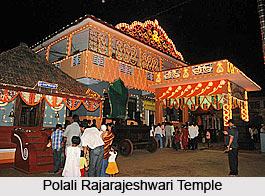 Shri Kshetra Polali is in the heart of this village surrounded by high hillocks and wide paddy fields. Puliapura is its Sanskrit version. This temple has been mentioned in the Ashokan inscriptions. Queen Chennammaji of Keladi constructed a grand chariot for the temple. Polali is a pilgrimage centre that attracts several tourists.
Shri Kshetra Polali is in the heart of this village surrounded by high hillocks and wide paddy fields. Puliapura is its Sanskrit version. This temple has been mentioned in the Ashokan inscriptions. Queen Chennammaji of Keladi constructed a grand chariot for the temple. Polali is a pilgrimage centre that attracts several tourists.
Polali Chendu is a festival of this temple. It is believed that Shri Lalitha Devi was the full incarnation of Shri Bhuvaneshwari and after her coronation she was called Shri Rajarajeshwari. Her sacred story is as follows:
After death of his wife Gouri, Lord Rudra renounced all activities. Kama the God of Love shot Rudra with his flits of love. Rudra opened his third eye and burnt Kama into ashes. After several years Lord Ganesha made a human form with that ash and placed it before Rudra. Lord Rudra looked at it with sympathy and it became a living being. Nandikeshwara initiated him with the holy mantra of Rudra. The ash born repeated the mantra with inherent faith and prayed to Lord Shiva. Lord Shiva was pleased with him and granted him many boons. He became famous and was known as Bhandasura.
Guru Shrukracharya, took him to Shonithapura and crowned him as the King of asuras. Shukracharya initiated Bhandasura with many mantras of mysterious power. Bhandasura did a severe penance and received many boons that made him very powerful. He began to torture the people. With the advice of Divine sage Narada the impoverished Gods engaged themselves in meditation, worship and penance to make the Divine Mother visible before them. Shri Bhuvaneshwari in Manidweepa saw the sufferings and penance of Gods and appeared before them in the form of Lalitha Devi. It is the full incarnation of Goddess Bhuvaneshwari.
A battle started between the army of goddess and army of Bhandasura. His brothers, nephews, relatives and ministers, army chief and large army died fighting against the army of the Goddess. On fifth day Bandasura himself came and fought against the Goddess and died. King Suratha installed and worshiped Shri Rajarajeshwari. Some of the special occasions are Simha Sankramana, Souramana Ugadi, Gokulashtami, 4th day of Bhadrapada Shukla, Kadiru Habba (Corn Festival), Navaratri Festival, Diwali, Kartika Bahula Padya, Laksha Deepotsava, Subramanya Panchami and Shashti Festivals, Dhanurmasotsava, shivaratri and the Annual Festival (commences on Sankranthi day of month of Meena)
The festival of Polali Chendu during the Annual festival commences when there are seven days to the avabritha. This continues for five days. Members of a cobbler family at Mijar prepare the leather ball that is used for the game. The members of oil miller family of `Kadapu Karia` bring the leather ball from Mijar. While coming back they come to the house of Malali Ballal. They first place the ball in the cow dung washed front yard of the house and inform them the date of the football festival.
In the evening members of the Gutthu families occupy their respective places on both sides of the front gopuram. The members of the oil miller family then place the ball and a palm leaf umbrella in the gopuram. A person who is authorized to throw the ball arrives there wearing his headgear. He offers prayers to the deity in the presence of the members of the Gutthu. Thereafter the members of the Gutthu families go to the `Sultan Katte` near the football field and wait there. The honourable person who is authorized to throw the ball then comes to football field.
Game begins when he throws the ball. When the ball reaches either the southern or northern bund of the field it is again given to the authorized person to be thrown again. The ball is thrown out three times and this procedure is repeated for five days. When three games are over the person authorized to throw the ball returns with it to the temple thereby occupying his seat in the gopuram. Some specified persons are offered betal leaves and areca nuts and honoured in the presence of the head of Gutthus. The final Polali festival is well known.











